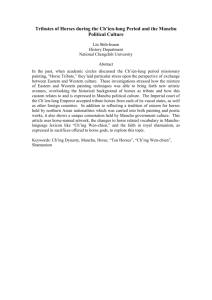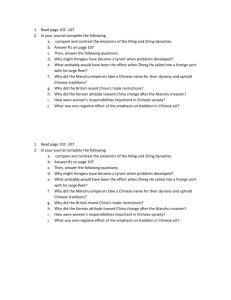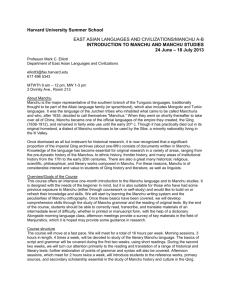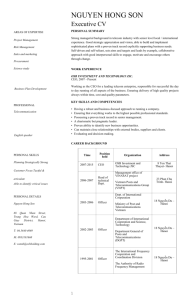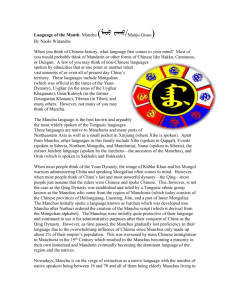The Legacy of Hanoi Shan - The Official Philip Jose Farmer Home
advertisement
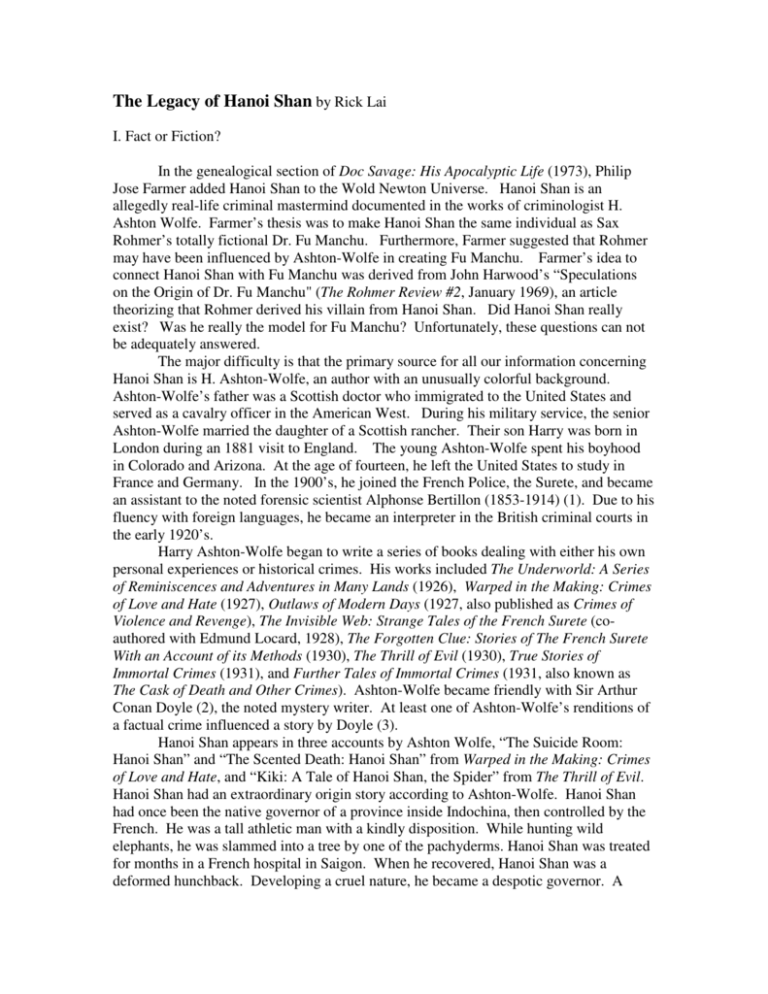
The Legacy of Hanoi Shan by Rick Lai I. Fact or Fiction? In the genealogical section of Doc Savage: His Apocalyptic Life (1973), Philip Jose Farmer added Hanoi Shan to the Wold Newton Universe. Hanoi Shan is an allegedly real-life criminal mastermind documented in the works of criminologist H. Ashton Wolfe. Farmer’s thesis was to make Hanoi Shan the same individual as Sax Rohmer’s totally fictional Dr. Fu Manchu. Furthermore, Farmer suggested that Rohmer may have been influenced by Ashton-Wolfe in creating Fu Manchu. Farmer’s idea to connect Hanoi Shan with Fu Manchu was derived from John Harwood’s “Speculations on the Origin of Dr. Fu Manchu" (The Rohmer Review #2, January 1969), an article theorizing that Rohmer derived his villain from Hanoi Shan. Did Hanoi Shan really exist? Was he really the model for Fu Manchu? Unfortunately, these questions can not be adequately answered. The major difficulty is that the primary source for all our information concerning Hanoi Shan is H. Ashton-Wolfe, an author with an unusually colorful background. Ashton-Wolfe’s father was a Scottish doctor who immigrated to the United States and served as a cavalry officer in the American West. During his military service, the senior Ashton-Wolfe married the daughter of a Scottish rancher. Their son Harry was born in London during an 1881 visit to England. The young Ashton-Wolfe spent his boyhood in Colorado and Arizona. At the age of fourteen, he left the United States to study in France and Germany. In the 1900’s, he joined the French Police, the Surete, and became an assistant to the noted forensic scientist Alphonse Bertillon (1853-1914) (1). Due to his fluency with foreign languages, he became an interpreter in the British criminal courts in the early 1920’s. Harry Ashton-Wolfe began to write a series of books dealing with either his own personal experiences or historical crimes. His works included The Underworld: A Series of Reminiscences and Adventures in Many Lands (1926), Warped in the Making: Crimes of Love and Hate (1927), Outlaws of Modern Days (1927, also published as Crimes of Violence and Revenge), The Invisible Web: Strange Tales of the French Surete (coauthored with Edmund Locard, 1928), The Forgotten Clue: Stories of The French Surete With an Account of its Methods (1930), The Thrill of Evil (1930), True Stories of Immortal Crimes (1931), and Further Tales of Immortal Crimes (1931, also known as The Cask of Death and Other Crimes). Ashton-Wolfe became friendly with Sir Arthur Conan Doyle (2), the noted mystery writer. At least one of Ashton-Wolfe’s renditions of a factual crime influenced a story by Doyle (3). Hanoi Shan appears in three accounts by Ashton Wolfe, “The Suicide Room: Hanoi Shan” and “The Scented Death: Hanoi Shan” from Warped in the Making: Crimes of Love and Hate, and “Kiki: A Tale of Hanoi Shan, the Spider” from The Thrill of Evil. Hanoi Shan had an extraordinary origin story according to Ashton-Wolfe. Hanoi Shan had once been the native governor of a province inside Indochina, then controlled by the French. He was a tall athletic man with a kindly disposition. While hunting wild elephants, he was slammed into a tree by one of the pachyderms. Hanoi Shan was treated for months in a French hospital in Saigon. When he recovered, Hanoi Shan was a deformed hunchback. Developing a cruel nature, he became a despotic governor. A native uprising led to his flight from the Far East. Arriving in Paris, he sought unsuccessfully to find a surgeon to cure his injured spine. When this search became fruitless, he assumed the alias of “the Spider” to become a major power in the French underworld. He was also known to commit crimes in London (4). “The Suicide Room: Hanoi Shan” involved a series of murders inside the suite of a Parisian hotel during 1906. The initial victim was an Englishman carrying diamonds from South Africa. The hotel room was connected to a secret passageway from which Hanoi Shan released an anesthetic gas. Once the victim was unconscious, Hanoi Shan and his minions secretly entered the room. They killed the sleeping Englishman by hanging him and stole the diamonds. The murder was made to look like suicide. After the death gained wide notoriety in the newspapers, there occurred a series of similar murders in which the victims were later occupants of the same room. They were not robbed like the Englishman. Hanoi Shan was solely killing them to create the illusion that the hotel room was cursed. Realizing that Hanoi Shan must be behind the deaths, Alphonse Bertillon convinced Ashton-Wolfe and James P. Bannister, an American working for the Pinkerton Detective Agency (5), to set a trap in the hotel room by posing as commercial travelers. Using respirators, Ashton-Wolfe and Bannister shielded themselves from the sleeping gas. When Hanoi Shan and his accomplices invaded the room, Bannister fired a pistol at them. Hanoi Shan escaped with two bullet wounds in the stomach, but his followers were apprehended. The hunchback recovered from his injuries to terrorize French society further. “The Scented Death: Hanoi Shan” took place shortly after the events of the earlier case. 1907 appears to be the year of this episode (6). One of Hanoi Shan’s underlings, Cordoni, murdered a wealthy Dutch diamond merchant. The merchant was rendered unconscious by a drug derived from an Asian spider. Cordoni then slew the merchant with an overdose of morphine. Hanoi Shan’s agent plundered a fortune in diamonds from the victim’s safe. Due to Bertillon’s deductions, the police were able to arrest Cordoni. The authorities of Naples arrested an Asian hunchback who was believed to be Hanoi Shan. However, the apprehended hunchback was revealed to be a double. While in custody, the bogus Hanoi Shan committed suicide with cyanide. “Kiki: A Tale of Hanoi Shan: the Spider” concerned Raoul Ladoux, alias La Belle Lisette. Ladoux was a female impersonator working for Hanoi Shan in 1908. Ladoux romanced wealthy men while disguised as a woman. When the would-be Lotharios took Ladoux into their apartments, the transvestite murdered them and stole their possessions. Bertillon again discerned the truth, but the police were only able to capture Ladoux. He was sentenced to the guillotine. Hanoi Shan remained at large. According to “The Scented Death: Hanoi Shan,” Hanoi Shan perished years later. During the salvage of a derelict steamer, Hanoi Shan attempted to cheat one of his own men. The enraged henchman slew Hanoi Shan. Ashton-Wolfe did not elaborate on the exact manner of Hanoi Shan’s demise. Although these works were printed as non-fiction, the question arises whether they are accurate. Ashton-Wolfe supplied photos to buttress his claims of authenticity, but the stories don’t have the ring of truth. Ashton-Wolfe wrote in a sensationalized style. Dialogue was attributed to the real-life Alphonse Bertillon that makes him sound like a cross between Sherlock Holmes and Sexton Blake. For example, there is this utterance: “It is that cunning Oriental and his female impersonator. What a devilish scheme!” Even if there is a factual basis for these crimes, Ashton-Wolfe could have significantly exaggerated them. Ashton-Wolfe was certainly capable of spreading disinformation. “The Story of Jean Orth” from The Underworld: A Series of Reminiscences and Adventures in Many Lands is loaded with untruths. Jean Orth was supposedly an alias adopted by the heir to the throne of Austria-Hungary. When he married against the wishes of the Hapsburg Emperor, Austrian agents kidnapped his wife and spirited her away to Asia. Adopting the name of Jean Orth, the royal heir would eventually perish as a member of the French Foreign Legion. The story is pure balderdash. In fact, it is a variation of a false rumor concerning Archduke Franz Ferdinand, the Austrian heir whose 1914 assassination sparked World War I. Supposedly Emperor Franz Joseph was so enraged by Franz Ferdinand’s engagement to Countess Sophie Chotek that Imperial agents abducted the lady and confined her to a nunnery. Franz Ferdinand allegedly rescued his beloved from this imprisonment (7). Inaccurate claims also permeate Ashton-Wolfe’s re-creations of historical crimes. In “The Man in the Iron Mask” from True Stories of Immortal Crimes, Ashton-Wolfe asserted that he found historical documents indicating that the mysterious prisoner was truly a brother of Louis XIV as dramatized by novelist Alexandre Dumas. Such a possibility has been ruled out by all serious historians who have examined the mystery of the Man in the Iron Mask. In “Dr. Guillotin and the Guillotine” from Further Tales of the Immortal Crimes, Ashton-Wolfe repeated a falsehood about the physician for whom the French decapitation machine was named. Guillotin was supposedly beheaded by the execution machine during the reign of Napoleon I. The truth is that Guillotin died from natural causes. Doubts about the existence of Hanoi Shan are also exposed by “The Death Planes: A Story of the First Aerial Pageant at Rheims, 1909” from Warped in the Making: Crimes of Love and Hate. The events of this case are very hard to accept as truth. Ashton-Wolfe supposedly tangled with Paul Nerinsky, another maniacal hunchback. Nerinsky was employed by an unnamed foreign government (seemingly Germany) to sabotage an aviation exhibition in France. Nerinsky was never brought to trial because he conveniently committed suicide by shooting himself in the head. In order to avoid a diplomatic incident, all the details of Nerisnsky’s activities were kept out of the newspapers. Are we to believe that Ashton-Wolfe fought two homicidal hunchbacks in the course of his life? Alphonse Bertillon was a real criminologist. An examination of his life should mention these weird cases involving Hanoi Shan. A biography of the investigator, Alphonse Bertillon: Father of Scientific Detection (George G, Harrap, 1956) by Henry T. F. Rhodes, doesn’t cite any encounters with this master criminal. At this point, I strongly suspected that Hanoi Shan was a figment of Ashton-Wolfe’s imagination, but there are two writers who confirm the existence of Hanoi Shan. Max Haines writes a newspaper column for the Toronto Sun and has published several books of “true crime” stories. Occasionally he does “flashbacks" to historical mysteries. On Jan. 23, 1988, his “flashback” column was called “Enter the Death Room,” which was another version of the events described by Ashton-Wolfe’s “The Suicide Room: Hanoi Shan.” The account by Haines was told in a much more believable manner. Haines did not offer any outrageous origin story for Hanoi Shan. There are no major contradictions when comparing Ashton-Wolfe and Haines. It is quite possible that Haines used Ashton-Wolfe as his primary source for the story. A very different version of the 1906 murders can be found Charles Higham’s The Adventures of Conan Doyle (1976), a biography of the creator of Sherlock Holmes. Higham believed that Doyle’s “The Adventure of the Devil’s Foot” was based on that case: “In this respect, the story recalls the notorious Hanoi Shan case in Paris of 1906 in which the victims were found staring and dead, killed by poisonous emanations of another plant.” Higham’s brief summary differs from Ashton-Wolfe’s narrative. Ashton-Wolfe never identified the source of the gas used in the hotel room murders, and he attributed the death of the victims to strangulation. My own personal belief is that there were some real crimes that formed the basis for Ashton-Wolfe’s tales of Hanoi Shan, but that the criminologist embellished the truth. At the very least, I don’t give any credence to the origin story about a wild elephant hunt in Indochina. II. The Literary Descendants of Hanoi Shan The first Fu Manchu story by Sax Rohmer was written in 1912. Ashton-Wolfe’s accounts of Hanoi Shan were first published in 1927. Rohmer certainly wasn’t influenced by Ashton-Wolfe in the creation of Fu Manchu. If Hanoi Shan has a basis in fact, then Rohmer could only have been inspired by newspaper reports of the deranged hunchback. On the other hand, Rohmer’s popular books about Fu Manchu could have led Ashton-Wolfe to introduce distortions into his depictions of Hanoi Shan. Despite the fact that Ashton-Wolfe’s stories did not have an impact on Rohmer, they did have an effect on two other popular writers of escapist fiction. Under the pseudonym of Sapper, Herman Cyril McNeile recorded the adventures of Bulldog Drummond, a World War I veteran who constantly found himself embroiled with diabolical masterminds. In Temple Tower (1929), McNeile drew heavily on the works of Ashton-Wolfe to fashion a European version of Hanoi Shan. Besides AshtonWolfe’s stories about Hanoi Shan, McNeile also borrowed from the author’s accounts of Jules Bonnot and Octave Garnier, a pair of robbers who committed crimes by automobile (8). McNeile’s novel was set in June 1928 (9). The villain of the exploit was Le Bossu Masque (“The Masked Hunchback”). This crime boss posed as a cripple by wearing a false hump. He disguised his face with a long black hood. The arch-felon was also dubbed the Silent Strangler because he delighted in choking people to death. In 1898, the fake hunchback rose to the top of the French underworld. He organized a series of robberies using motor cars. In September 1902, Le Bossu Masque engineered the theft of a collection of emeralds from a Russian prince residing in France. One of the hunchback’s minions, “Le Crapeau” (10), double-crossed his boss and absconded with the gems. “Le Crapeau” retired to a fortified English estate. More than two decades later, Le Bossu Masque arrived in England to retrieve the jewels. Instituting a series of murders to achieve his goal, the criminal came into conflict with Drummond. Details of the past of Le Bossu Masque are given to Drummond by Victor Matthews, an American who served with the French police in the early twentieth century. Matthews was based on H. Ashton-Wolfe. In addition to Hanoi Shan, McNeile drew elements from popular characters of French fiction when fashioning his masked villain. There is a touch of Fantomas, the criminal genius devised by Pierre Souvestre and Marcel Allain, in Le Bossu Masque. McNeile also modeled his villain partially on Lagardere, the dueling hero who posed as a hunchback in Paul Feval’s historical swashbuckler, Le Bossu (1857). Seabury Quinn depicted the adventures of Jules de Grandin, an occult detective, in the classic pulp magazine Weird Tales. Although born in France, de Grandin moved to the United States in the 1920’s. The only recurring adversary to battle de Grandin was Dr. Sun Ah Poy, who appeared in “The Lost Lady” (January 1931) and “Satan’s Stepson” (September 1931). Sun Ah Poy has an origin story virtually identical to Hanoi Shan’s. A Chinese resident of Saigon who graduated from the Sorbonne, Sun Ah Poy was a man highly respected by the French colonial rulers of Indochina. During the supervision of an elephant hunt, Sun Ah Poy suffered the exact same injury that Ashton-Wolfe attributed to Hanoi Shan. The injury drove Sun Ah Poy to become an insane master criminal. He instituted a series of rebellions and acts of sabotage inside Indochina. When the French authorities deduced his culpability, Sun sought refuge inside a Cambodian temple. There he became infatuated with a temple dancer. When she left Cambodia to marry an American, Sun pursued her to the United States. Sun’s obsessive persecution of the dancer escalated into a battle with de Grandin in “The Lost Lady.” In the course of his duel with de Grandin, Sun not only used poisonous insects and reptiles like Fu Manchu, but also employed sorcery. Foiling Sun’s scheme, de Grandin had his adversary arrested by the American police. In “Satan’s Stepson,” we learned that Sun Ah Poy had been confined to an insane asylum. Sun’s role in this story was fairly minor. The main villain was Konstantin; a Russian sorcerer with certain similarities to the historical Rasputin Sun absconded from the asylum while de Grandin was warring with Konstantin. Sun and Konstantin briefly joined forces, but a disagreement between the two fiends resulted in Sun’s death. During their quarrel, Konstantin stabbed Sun. Regaining his sanity due to the pain of the fatal wound, a repentant Sun informed de Grandin of Konstantin’s whereabouts shortly before he died. After John Harwoood’s article on Hanoi Shan, Philip Jose Farmer put forth the theory that Hanoi Shan was the same person as Fu Manchu in Doc Savage: His Apocalyptic Life (1973). Farmer claimed that Hanoi Shan had his twisted spine corrected by surgery to become Fu Manchu. The story about Hanoi Shan being killed by a member of his own gang was classified as a false rumor circulated by Fu Manchu. Like Fu Manchu, both Bulldog Drummond and Jules de Grandin are members of the World Newton Universe. Farmer added Drummond to the interconnected cast of characters in Tarzan Alive: A Definitive Biography of Lord Greystoke (1973). The same book briefly mentioned the surname of de Grandin in a discussion oft the life of Tarzan’s relative, Sir William Clayton. Another writer, Lin Carter, tied together both Jules de Grandin and Fu Manchu in “Perchance to Dream,” part of a series of short stories about psychic sleuth Anton Zarnak (11). De Grandin made an actual physical appearance in the story, but Fu Manchu was merely cited under the alias of “an old adversary.” Somehow Hanoi Shan, Le Bossu Masque and Dr. Sun Ah Poy all co-exist in the same fictional universe. III. Speculation: The Other Daughter of Fu Manchu The theory that Fu Manchu was Hanoi Shan is not compatible with Sax Rohmer’s stories of the sinister savant. Fu Manchu did not start to engage in illegal activity beginning in the early 1900’s due to a sudden spinal injury The Island of Fu Manchu (1941) established that Fu Manchu was as active as early as 1880 (12). In that year, he investigated the existence of zombies in the island of Haiti. Discovering that zombies were manufactured by injecting human beings with drugs, Fu Manchu sought to ascertain the original source of these narcotics. He traveled from Haiti to Central Africa, the Sudan and finally Egypt. Fu Manchu unearthed the ancient archives of the priesthood of Thebes. In these records, he found a formula for a catalepsy-inducing drug that figured prominently in his illegal enterprises. In The Golden Scorpion (1919), the drug is described as F. Katalepsis, and its principal ingredient is given as the venom of the black scorpion of India. My theory to explain the discrepancy between the Egyptian and Indian references is that Fu Manchu learned that the Theban drug had been derived from a scorpion now extinct in Egypt. His subsequent research identified the black scorpion of India as a related species of the extinct arachnid. References to historical figures such as the Madhi and Horatio Kitchener in The Mask of Fu Manchu (1932) imply that Fu Manchu was in the Sudan and Egypt during 1882-1883. He must have left Egypt for India in 1884. Concerning the activities of Fu Manchu in the 1890’s, we have one definitive reference. The Bride of Fu Manchu (1933) featured Maitre Foli, a celebrated French lawyer who had served Fu Manchu for “over a period of forty years.” What was Fu Manchu doing in France in the 1890’s? The Bride of Fu Manchu noted that Fu Manchu had doctorates from four universities. Emperor Fu Manchu (1959) named three of the universities: Heidelberg, the Sorbonne and Edinburgh (chap. 17). Fu Manchu probably received his first degree in the 1870’s from the unnamed university (13), embarked on his travels through Haiti, Africa and India in the 1880’s, and then earned his three later doctorates in Europe during the late 1880’s and early 1890’s. According to The Bride of Fu Manchu, Fu Manchu became governor of the Chinese province of Honan during the reign of the Dowager Empress. This Imperial appointment must have happened during the 1890’s because The Return of Dr. Fu Manchu (1916, also known as The Devil Doctor) indicated that Fu Manchu participated on the Boxer Rebellion of 1900 The logical conclusion was that the failure of the Boxer Rebellion to expel Westerners from China caused Fu Manchu to lose his governorship (14). The Mask of Fu Manchu noted that Fu Manchu discovered a rare species of orchid in Burma around 1902 (15). Fu Manchu was then active in both Europe and Asia as the principal agent of the Si-Fan, an Asian secret society that professed to be older than Buddha. The Insidious Dr. Fu Manchu (1913, also published as The Mystery of Dr. FuManchu) offers some clues regarding Fu Manchu’s actions during 1906-1908, the years when Hanoi Shan was active in France. In 1908, Fu Manchu abducted Von Homber, a celebrated German engineer from Berlin, using his catalepsy-inducing drug (16). During 1908-1909, Fu Manchu was also behind the Call of Siva murders in Burma (Myanmar). These murders began at a hotel in Rangoon and then spread throughout Burma. The killings were committed by members of the cult of Thuggee. There exists a certain resemblance between the Call of Siva deaths and the 1906 strangulations perpetrated by Hanoi Shan at a Parisian hotel. Since it is impossible for Fu Manchu to have experienced a spinal injury, could he have been disguised as a hunchback like Le Bossu Masque? That fact that Hanoi Shan survived two bullet wounds inflicted by Bannister could be explained by the padding that a disguised person would have utilized when posing as a heavyset hunchback. The impact of Bannister’s bullets must have been blunted by the padding. There could have been a real Hanoi Shan who was an Indochinese governor. The legitimate Hanoi Shan came to France after his accident. He was then abducted by someone else. This person then used makeup to assume the identity of Hanoi Shan. As for the true Hanoi Shan, he was enslaved by his kidnapper to fool the police. The genuine Hanoi Shan was the hunchback arrested by the Neapolitan police in “The Scented Death: Hanoi Shan.” This hunchback then took his own life (17). The natural temptation would be to assume that Fu Manchu usurped the identity of Hanoi Shan. When Bannister and Ashton-Wolfe glimpsed Hanoi Shan in 1906, the mastermind had luminous eyes similar to Fu Manchu’s cat-green eyes. However, there are noted instances where two other people associated with Fu Manchu posed as a hunchback. In The Insidious Dr. Fu Manchu, Karamaneh, Fu Manchu’s chief female agent, impersonated a male hunchback. In The Trail of Fu Manchu (1934), Fah Lo Suee, Fu Manchu’s own daughter who took over Karamaneh’s duties, also disguised herself in the same manner. Fu Manchu must have reserved the hunchback disguise for his principal female assistant. Hanoi Shan’s employment of a transvestite operative, Raoul Ladoux, demonstrated that the criminal ringleader was very familiar with gender altering disguises. The vicious mastermind of 1906-8 must have really been a woman. There is a curious statement made by Sir Denis Nayland Smith, Fu Manchu’s chief adversary. In 1911, Smith made this assessment of Karamaneh: "She is either Fu Manchu' s daughter, his wife, or his slave. I am inclined to believe the last. .” (The Insidious Dr. Fu Manchu, chap. 3), Smith was correct about Karamaneh being a slave, but why did the intrepid investigator mention a daughter and a wife? Fah Lo Suee was only twelve years old in 1911, and Smith would not meet her until three years later (18). Had Smith heard rumors of an older daughter who helped Fu Manchu in his schemes? As well as a formidable wife? Evidence that Fu Manchu had another daughter surfaced in August Derleth’s “The Adventure of the Camberwell Beauty” from The Return of Solar Pons (1958). This story was a case of Solar Pons, a British sleuth who was a student of Sherlock Holmes. “The Adventure of Camberwell Beauty” took place in May 1933 (19). Despite having been his opponent in the past, Fu Manchu hired Solar Pons to find a missing person. Fu Manchu’s ward, Cecily Kennet, had disappeared. Cecily’s antecedents are somewhat nebulous. Her father was Sir Cecil Kennet, a consular official in Rangoon. Her mother was an unnamed Eurasian woman who lived with Sir Cecil. Fu Manchu described Cecily’s mother as “a woman very dear to me.” The misguided scientist liked to call Cecily by the nickname of Karah. It can be assumed that Karah was the real name of Cecily’s mother. The impression was given that Cecily’s parents were both dead. Cecily graduated from Oxford two years before the events of “The Adventure of the Camberwell Beauty.” Therefore, she was probably twenty-four years old in 1933. Cecily must have been born in 1909. Fu Manchu had sworn to keep her segregated from his criminal operations. This decision gave the impression that Cecily’s mother died in Fu Manchu’s service. Cecily had green-blue eyes, and Fu Manchu’s eyes were green. Cecily must be Fu Manchu’s granddaughter. Fah Lo Suee was not Fu Manchu’s only daughter. She had an older sister named Karah. It was Karah who adopted the alias of Hanoi Shan. It was she who was behind both the 1906 hotel murders in Paris and the 1908-9 atrocities in Burma. It is not pure coincidence that the victims were throttled in both series of crimes. Karah must have been a member of Thuggee, the fanatical cult that slaughtered human beings through strangulation. The secret society cloaked under the name of the Si-Fan worshipped a goddess. In The Hand of Fu Manchu (1917, also known as The Si-Fan Mysteries), this female deity was depicted as the Lady of the Si-Fan. The Si-Fan believed that the Lady had existed in an earthly incarnation at various points in history. A woman was proclaimed the Lady of the Si-Fan during the reign of Kublai Khan, the first Yuan Emperor. Fah Lo Suee sought to assume the role of the Lady of the Si-Fan in The Hand of Fu Manchu. Pursuing similar ambitions in Daughter of Fu Manchu (1931), Fah Lo Suee dressed like Kali, the Hindu goddess revered by the Thugs of India. The Si-Fan was a confederation of multiple criminal organizations and barbarous cults. The Thugs were a major component of the Si-Fan. The legend of the Lady of the Si-Fan must be related to the goddess Kali (20). Obsessed with reviving the Si-Fan as a powerful force in world events, Fu Manchu would have sought mastery over the cult of Thuggee. This would be easy to achieve if he had married a high priestess oft the cult. The existence of such a high priestess was made known in Sir Arthur Conan Doyle’s “Uncle Jeremy’s Household” (21). The story was set in 1862. The main character was a young woman known as Miss Warrender. She was born in 1842 (22). Her father was Achmet Genghis Khan, an Indian chieftain of Jubbulpore (“Jublepore” in Doyle’s tale). He married an Englishwoman named Warrender. During the Sepoy Mutiny of 1857, Achmet took up arms against the British. Both he and his English wife were slain in the fighting. Their daughter was adopted by a German merchant from Calcutta. The merchant brought the girl now called Miss Warrender to Europe. Miss Warrender possessed homicidal tendencies. Her father had been the secret head of Thuggee, and she had been raised to practice human sacrifice. In accordance with her religion, she strangled the German merchant’s daughter as an offering to Kali. Miss Warrender journeyed to England where she became the governess to three young children. One of her wards, a young girl, became another of Miss Warrender’s victims. A disciple of Achmet Genghis Khan located Miss Warrender in England. He persuaded the governess to flee England in order to assume her father’s place as the leader of the Thugs of India. The story concluded with Miss Warrender escaping legal retribution for her crimes. We can only assume the Miss Warrender returned to India to accomplish her goals. She could have been ruling the cult in the late 1870’s. Fu Manchu earned his first medical degree by that time, and could have been seeking a current incarnation of the Lady of the Si-Fan. Miss Warrender could easily be cast in that role. Not only was she descended from a long lineage of Thuggee leaders (23), but her father’s name raises the possibility that the blood of Genghis Kan, the great Mongolian conqueror, may even have flowed in her veins (24). Fu Manchu may not have been the only megalomaniac seeking to contact Miss Warrender. Arthur Morrison’s The Red Triangle (1903) detailed the crimes of Mayes, a renegade Englishman who practiced Haitian voodoo (25). After participating in the native rebellion in Jamaica during 1865, Mayes fled to Haiti. Evolving into a secret power broker manipulating the brutal politics of the island, he amassed great power during the administration of Michel Domingue (1874-76). When Domingue was overthrown, Mayes disappeared from the Western Hemisphere. He eventually resurfaced in England in 1898 (26), but his movements for over twenty years were shrouded in secrecy. It was rumored that Mayes was in China for some of these missing years. The favorite murder method employed by Mayes was strangulation by a tourniquet. His talent as a strangler would have prompted him to visit India and research the cult of Thuggee. In either China or India, Mayes and Fu Manchu could have crossed paths. Mayes must have been the person who informed Fu Manchu about the mysteries surrounding the creation of Haitian zombies. Hoping to resurrect the Si-Fan, Fu Manchu would have married Miss Warrender. For a honeymoon trip, Fu Manchu and his Thuggee bride must have traveled to Haiti in the Caribbean in 1880. The couple then went to Central Africa. In The Return of Dr. Fu Manchu, we learned the Fu Manchu owned a baboon from Abyssinia (Ethiopia). Fu Manchu must have collected specimens of this species of baboon by taking a side trip to Ethiopia before continuing to the Sudan. There is strong reason to believe that Miss Warrender left Fu Manchu’s company in Ethiopia and embarked on a boat on the African coast that returned her to India. The evidence for this belief can be found in Doyle’s famous Sherlock Holmes story, “The Adventure of the Speckled Band.” This story details the career of Dr. Grimesby Roylott. In India during 1853, Roylott married Mrs. Stoner, a widow with two young twin daughters, Helen and Julia (27). After killing a man in anger, Roylott was sentenced to a long term of imprisonment. By 1875, he was back in England. His wife died in a railway accident during that year (28). Mrs. Roylott bequeathed a certain amount of money to her daughters when they married. Roylott did not wish to share his wife’s fortune with his step-daughters. When Julia Stoner became engaged to be married, Roylott murdered her using an Indian snake. In 1883, Helen’s life became endangered because she also announced a betrothal. Sherlock Holmes prevented Roylott from killing Helen. Roylott died from the bite of his own snake. Roylott had a menagerie of animals that were mailed to him from a nameless correspondent in India. In addition to the snake, his pets included a cheetah and a baboon. While a cheetah is indigenous to India, a baboon can only be found in Africa. Roylott’s Indian correspondent was someone who had access to unusual animals. This person could easily be the Indian wife of Fu Manchu. Sherlock Holmes identified Roylott’s snake as “the swamp adder . . . the deadliest snake in India.” There is no species of snake like this reptile recognized by zoologists. What is this snake? It must be a serpent raised secretly by the cult of Thuggee. How does Holmes know about it? The answer lies in “Uncle Jeremy’s Household.” Miss Warrender’s activities of 1862 were investigated by Hugh Lawrence, a resident of Baker Street. Holmes also resided there. Lawrence was drawn into the Warrender case by his friend John H. Thurston. In “The Adventure of the Dancing Men,” it was mentioned that Dr. Watson, the narrator of the cases of Sherlock Holmes, regularly played billiards with a man named Thurston. The circumstantial evidence is very strong that Lawrence and Thurston knew Holmes and Watson. Before he discovered her murderous nature, Lawrence discussed India with Miss Warrender. She could have mentioned the existence of the venomous swamp adder to Lawrence, who later passed on this information to Holmes. In “The Adventure of the Mazarin Stone,” Holmes stated that he had “the complete history of Miss Minnie Warrender” in his files. Miss Minnie Warrender must be the same person as the murderess of “Uncle Jeremy’s Household.” Holmes learned her history from Lawrence and Thurston, but the great detective’s records were not as “complete” as he suggested. Holmes knew nothing about Miss Warrender’s relationship to Fu Manchu. “Minnie” is probably a derivation of the Indian name “Mina” (which means “jewel” or “fish”) or the feminine Indian nickname “Mini” (which means “small”). During his imprisonment in India, Dr. Roylott could have met fellow inmates who were connected to Thuggee. One of these felons must have informed Minnie Warrender about the embittered Englishman. Minnie could have recognized that Roylott would be the perfect candidate to become an agent of her cult in England. She cultivated Roylott after his release from prison. Minnie was Roylott’s Indian correspondent. She mailed him the swamp adder in the late 1870’s. The baboon was later dispatched to Roylott in 1881 after Fu Manchu’s bride returned to India with specimens of the ape from Ethiopia. Why did Minnie leave her husband in Africa in that year? The answer is obvious. She was pregnant with Fu Manchu’s daughter. Karah must have been born in 1881. I propose that the wife of Achmet Genghis Khan was named Sarah Warrender. Minnie christened her daughter Karah because the name combined Sarah with Kali. Recognizing the importance of the quest for a catalepsy-inducing drug, Minnie did not insist that her husband accompanied back to India. Sherlock Holmes mentioned that he possessed Minnie Warrender’s history to Count Negretto Sylvius, an accomplished forger and thief. This conversation is generally believed to have occurred in 1903. Sylvius implied that the information about Minnie Warrender couldn’t be used to incriminate him. There is an alternate version of this conversation in “The Crown Diamond,” a play by Sir Arthur Conan Doyle (29) that is a slightly different version of the events described in “The Adventure of the Mazarin Stone.” In this parallel account, Holmes referred to “real facts as to the death of Miss Minnie Warrender of Laburnum Grove.” This statement suggested that Minnie Warrender was murdered. However, it is not Count Sylvius whom Sherlock Holmes implied was responsible for Miss Warrender’s demise. The unscrupulous nobleman was replaced by another character on the stage. In “The Crown Diamond,” Holmes was talking to Colonel Sebastian Moran, a much more formidable figure in the underworld. Although “The Crown Diamond” is a non-canonical adventure of Sherlock Holmes, it may hide a hidden truth. Could Colonel Moran have assassinated Minnie? Colonel Moran was the chief of staff to Professor Moriarty, the most powerful criminal in Britain. In “The Adventure of the Empty House,” Holmes had Moran arrested for the murder of Ronald Adair in 1894. Holmes told Watson that he suspected Moran of being implicated in an earlier murder. The victim was identified by Holmes as Mrs. Stewart of Lauder in 1887. Lauder is a town in central Scotland. Fu Manchu and his Thuggee bride wanted to establish indigenous agents in Britain. Minnie lost Grimesby Roylott as an agent in 1883 due to the intervention of Sherlock Holmes. She could have gone to Scotland under the alias of Mrs. Stewart. There she intended to erect her own criminal network by recruiting professional criminals like Count Sylvius. When Professor Moriarty realized that Minnie was trying to build a rival syndicate, he ordered Moran to liquidate her (30). During his investigation of the murder, Holmes recognized that Mrs. Stewart was the same person as Miss Minnie Warrender from Hugh Lawrence’s 1862 case. With Minnie’s death, Count Sylvius shifted his attention to other enterprises that did not compete with the Moriarty gang. There has always been a great mystery about the final fate of Colonel Moran. He should have been hanged for Adair’s murder. Years after Moran’s arrest, Holmes noted that the criminal was still alive in “The Adventure of the Illustrious Client.” As late as 1914 (“His Last Bow’), Holmes spoke of Moran in the present tense. The only way for Moran to escape execution would have been to be declared insane. In The Insidious Dr. Fu Manchu, Fu Manchu utilized a drug that could drive a man to madness. This drug was manufactured using “the venom of a kind of swamp adder” (chap. 27). This swamp adder must have been the same reptile that was used by Roylott. The venom employed by Fu Manchu always brought madness and sometimes death. Julia Stoner and Roylott were killed by the venom of the reptile, but Fu Manchu’s serum was a weakened variant that generally breed insanity. In retaliation for the death of Minnie, Fu Manchu could have arranged for Moran to be fed the insanity drug in prison while he was awaiting trial. Fu Manchu wanted Moran to suffer a lingering existence as a maniac. Moran was never sentenced to the gallows because he was confined to an asylum. At the time of Minnie’s death in 1887, Fu Manchu would have been baffled as to the parties responsible for her death. When Moran’s arrest generated publicity in 1894, Fu Manchu realized the truth and took his revenge (31). No action was taken against Professor Moriarty because he had died in 1891 (as told in Doyle’s “The Final Problem”). In respect to his late wife’s wishes, Fu Manchu would have allowed Karah to be raised in Asia as a worshipper of Kali. Fu Manchu pursued his post-graduate studies at three universities during the 1890’s. While studying at the Sorbonne, he recruited Maitre Foli as an agent. Fu Manchu was probably at the University of Edinburgh when Moran was arrested. Returning to China, Fu Manchu was appointed governor of Honan by the Dowager Empress. In 1899, Fu Manchu had an affair with a Russian woman that resulted in the birth of Fah Lo Suee (32). When the failure of the Boxer Rebellion of 1900 resulted in his dismissal from office, Fu Manchu shifted his attention again to Europe. Taking Karah with him, he arrived in France. Karah was entrusted with establishing a subsidiary organization there. Karah became interested in Le Bossu Masque when she heard of his prowess as a strangler. Around 1905, she infiltrated his gang. Launching a rebellion against the European hunchback, she gained control of his followers. Le Bossu Masque went into hiding and remained dormant until 1928. The real Hanoi Shan, a true hunchback, came to Paris in the hopes of finding a medical solution to his spinal condition. Karah enslaved Hanoi Shan in order to impersonate him. Expanding on an abandoned disguise of Le Bossu Masque, Karah lurked in the shadows as a false hunchback. She was the author of the 1906-8 crimes depicted by Ashton-Wolfe. Karah trained French criminals to perform rituals murders in the manner of Thuggee (33). In late 1908, Karah returned to Asia still using her Hanoi Shan identity. She inaugurated the Call of Siva strangulations in Burma. In her real guise, Karah seduced Sir Cecil Kennet, a British diplomat. Karah abandoned the Call of Siva campaign in 1909 because she discovered that she was pregnant with Kennet’s child. Their daughter Cecily was born later in the same year. In 1910, Karah returned to her campaign of violence resuming her Hanoi Shan alias. Thoroughly corrupting Sir Cecil, she utilized him in a scheme to make huge profits through the salvage of derelict steamers off the Burmese and Indochinese coasts. As a law-abiding ally of the colonial administrators, Dr. Sun Ah Poy heard of this scheme and started a campaign to counter it. Sun spread a rumor that Hanoi Shan was planning to cheat his underlings. This disinformation led to the assassination of Karah in her Hanoi Shan guise by one of her own agents. The same disgruntled lackey also slew Sir Cecil. Nayland Smith investigated Sir Cecil’s murder. By 1911, Smith had realized that Sir Ceil had been leaking information to a powerful Asian crime syndicate. Smith’s pursuit of this line of inquiry led to his first meeting with Fu Manchu in the jungles of Burma. In the course of his early pursuit of Fu Manchu, Smith heard rumors of a daughter named Karah. For a brief while, Smith wrongly assumed that Karamaneh was this daughter because of the similarity of her name to Karah. Later Smith deduced that Karamaneh was not Fu Manchu’s daughter. The legacy of Hanoi Shan continued despite Karah’s death. Fu Manchu had his female operatives utilize hunchback disguises in the tradition of his dead daughter. However, he refused to permit one of these subordinates to be Karah’s child. Having lost both Cecily’s mother and her grandmother in pursuit of his ambitions, Fu Manchu swore that such a fate would never befall his granddaughter. She was kept isolated from the operations of the Si-Fan. Fu Manchu eventually punished Sun Ah Poy for his role in Karah’s death. When Sun went to supervise an elephant hunt in 1918, Si- Fan agents abducted him. Fu Manchu used surgery to transform Sun into a hunchback. Fu Manchu also injected Sun with the venom of the swamp adder. Like Colonel Moran, Sun was driven insane. Fu Manchu then circulated the false story that Sun had suffered an accident just like the real Hanoi Shan (34) Fu Manchu had turned Sun Ah Poy into a real-life version of the misshapen madman that his daughter had pretended to be. CHRONOLOGY 1842 Birth of Miss Minnie Warrender. 1851 Birth of Julia and Helen Stoner. 1853 Grimsbey Roylott marries Mrs. Stoner. 1857 Death of Achmet Genghis Khan and his wife Sarah. 1862 Events of “Uncle Jeremy’s Household.” Minnie Warrender becomes head of the Thuggee cult in India. 1865 Mayes flees Jamaica and settles in Haiti. 1875 Death of Mrs. Stoner. 1876 The overthrow of Michel Domingue causes Mayes to leave Haiti and seek refuge in the Far East. 1879 Minnie Warrender sends Roylott a swamp adder from India. Mayes tells Fu Manchu about Haitian zombies. Fu Manchu searches for Minnie in Asia. 1880 Fu Manchu marries Minnie and travel with her to Haiti. 1881 Fu Manchu and his wife visit Central Africa and Ethiopia. A pregnant Minnie returns to India with several baboons. One of the apes is mailed to Roylott in England. Roylott murders Julia Stoner with the swamp adder. Birth of Karah. 1882 Fu Manchu meets the Madhi in the Sudan. 1883 In Egypt. Fu Manchu encounters Horatio Kitchener and discovers the records of the Theban priests. Death of Grimesby Roylott (“The Adventure of the Speckled Band”). 1884 Fu Manchu is reunited with his family in India. 1887 Under the alias of Mrs. Stewart, Minnie settles in Lauder, Scotland. She attempts to establish a criminal gang by recruiting Count Sylvius. Acting under orders from Professor Moriarty, Colonel Moran murders Minnie. 1891 Death of Professor Moriarty (“The Final Problem”). 1892 While studying at the Sorbonne, Fu Manchu recruits Maitre Foli as his agent. 1894 Sherlock Holmes engineers the arrest of Colonel Moran (“The Adventure of the Empty House”). While enrolled at the University of Edinburgh, Fu Manchu arranges for Moran to be driven insane by the venom of the swamp adder. 1898 Mayes commits crimes in England (The Red Triangle). Le Bossu Masque becomes a power in the French underworld. 1899 Birth of Fah Lo Suee. 1900 As governor of Honan, Fu Manchu participates in the Boxer Rebellion. 1902 Fu Manchu discovers rare orchids in Burma. Le Bossu Masque orchestrates the theft of emeralds from a Russian prince in France. 1905 Karah ousts Le Bossu Masque as the leader of a gang of French criminals. She kidnaps Hanoi Shan and assumes his identity. 1906 Events of “The Suicide Room: Hanoi Shan.” 1907 Events of “The Scented Death: Hanoi Shan.” 1908 Events of “Kiki: A Tale of Hanoi Shan, the Spider.” Fu Manchu abducts Von Homber in Berlin. In Rangoon, Burma, Karah inaugurates the Call of Siva murders and romances Sir Cecil Kennet. 1909 Karah suspends her Call of Siva campaign when she discovers that she is pregnant. Birth of Cecily Kennet. 1910 As Hanoi Shan, Karah is murdered along with Sir Cecil by a rebellious member of her gang. The killer’s actions are prompted by false rumors disseminated by Sun Ah Poy. 1911 Nayland Smith has his first meeting with Fu Manchu in the jungles of Burma. 1918 Fu Manchu secretly transforms Sun Ah Poy into a deranged hunchback. It is falsely reported that Sun was injured in an accident during an elephant hunt. 1926 Sun Ah Poy tangles with Jules de Grandin (“The Lost Lady”). 1927 Death of Sun Ah Poy (“Satan’s Stepson”). 1928 Le Bossu Masque battles Bulldog Drummond (Temple Tower). 1931 Cecily Kennet graduates from Oxford. 1933 Solar Pons investigates the disappearance of Cecily Kennet (“The Adventure of the Camberwell Beauty”). NOTES 1. Bertillon is best known as the originator of anthropometry, a system that identified criminals based on their physical measurements, in the early 1880’s. This system was adopted in France, Britain and the United States. The system was imperfect, and sometimes two different criminals were identified as the same man as shown by the 1903 Will West case in Kansas. In the first decade of the twentieth century, fingerprinting replaced anthropometry as the standard method of identification used by law enforcement. 2. Ashton-Wolfe dedicated Outlaw of Modern Days to Doyle. 3. Warped in the Making: Crimes of Love and Hate includes the story of Mario Allivi, a swindler who attempted to sell a phony death ray to the Italian navy. This event became the basis for Doyle’s Professor Challenger story, “The Disintegration Machine.” Challenger even alluded to Allivi in the course of the story: “We have not forgotten a recent case where an Italian, who proposed to explode mines from a distance, proved upon investigation to be an arrant impostor.” 4. “The Suicide Room: Hanoi Shan” claims that the mastermind was responsible for the death of “Charles Langham, the Hatton Garden diamond merchant.” 5. Bannister’s first meeting with Ashton-Wolfe was told in “’La Glu,‘ Apache and Gentleman” from The Underworld: A Series of Reminiscences and Adventures in Many Lands. 6. According to Ashton-Wolfe, the details of the criminal trial resulting from this incident can be found in Chronique des Tribunaux, 1907-08. 7. See Gordon Brook-Shepherd’s Archduke of Sarajevo: The Romance and Tragedy pf Franz Ferdinand of Austria ( Little, Brown and Company, 1984), p. 65. This nunnery story also became the basis for a short story, “How Don Q. Played Substitute” in Katherine and Hesketh Prichard’s The New Chronicles of Don Q (1906, also known as Don Q in the Sierra). 8. Ashton-Wolfe first wrote of Bonnot and Garnier in “The Motor Bandits” from The Underworld: A Series of Reminiscences and Adventures in Many Lands. The author later re-told the same story in “Jules Bonnot and Octave Garnier: the Motor Bandits” in Outlaws of Modern Days. 9. Two chronological references establish 1928 as the year of Temple Tower. Jean Marillard, born in 1881, was forty-seven years old in the novel. Marillard was also sentenced to Devil’s Island for twenty-three years in 1902. His term of imprisonment concluded five years before the novel began. 10. McNeile translates this title as “the Toad,” but the correct French word for toad is “Crapaud.” “Crapeau” is not a real French word. 11. “Perchance to Dream” can be found in either Lin Carter’s The Xothic Legend Cycle (Chaosium, 1997) or Robert M. Price’s anthology, Lin Carter’s Anton Zarnak Supernatural Sleuth (Marietta Publishing, 2002). 12. See my article, “Some Chronological Observations on the Fu Manchu Series” : http://www.pjfarmer.com/woldnewton/Fu.pdf 13. Cay Van Ash’s “A Question of Time” from The Rohmer Review #17 (August 1977) argues that Fu Manchu obtained his first degree at the medical school founded by Christian missionaries in Canton. The Canton Hospital under the direction of John Glasgow Kerr (1824-1901) began to provide medical education for Chinese students as early as 1869. 14. This was argued by Cay Van Ash in “A Question of Time.” 15. See my article, “Fu Manchu Vs. Cthulhu” for a theory concerning the mandarin’s trip to Burma. http://www.pjfarmer.com/woldnewton/Articles8.htm#CTHULHU 16. Von Homber was abducted three years before the events of The Insidious Dr. Fu Manchu (chap. 22). Cay Van Ash placed the events of the novel in 1911. 17. It is possible that the hunchback in Naples didn’t really take cyanide in Naples. He could have taken F. Katalepsis. In which case, the hunchback could have been retrieved by Fu Manchu’s agents and revived with the antidote. 18. I concur with Cay Van Ash’s speculation that Fah Lo Suee was only fifteen when she first encountered Smith. This meeting happened in The Hand of Fu Manchu. Van Ash places the meeting in 1914. 19. Derleth’s original text gave the year a “193-.” Robert Patrick’s “A Chronology of Solar Pons,” published as an appendix to Derleth’s The Reminiscences of Solar Pons (1961). designated the year as 1933. 20. The Si-Fan appeared under the alias of the S. Group in Sax Rohmer’s “The Voice of Kali” (published in the United States in Short Stories, December 10, 1923). The S. Group employed a statue of Kali as its symbol. 21. “Uncle Jeremy Household” (also titled “The Mystery of Uncle Jeremy’s Household”) can be found in these collections: The Final Adventures of Sherlock Holmes (Castle Books, 1981), Masterworks of Crime and Mystery (Doubleday, 1982) and The Unknown Conan Doyle: Uncollected Stories (Doubleday, 1984). 22. Miss Warrender was fifteen at the time of the Sepoy Mutiny of 1857. 23. According to the film Indiana Jones and The Temple of Doom (1984), the cult of Thuggee was ruled by the maharajahs of Pankot, an Indian principality in the Punjab. In the film, Jones implied that the palace of Pankot was vacant from 1857 until 1935. Achmet Genghis Kan could easily have been the heir to the throne of Pankot. Thuggee was largely suppressed in the 1830’s. During that decade, Achmet could have fled the Punjab when the British identified Pankot as the headquarters of Thuggee. He relocated to Jubbulpore in central India. In the midst of the chaos surrounding the 1857 rebellion, Achmet could have briefly reclaimed the palace of Pankot just before his death. 24. Achmet Genghis Khan could have been a descendant of Babur, who founded the Mogul dynasty of emperors in India during 1526. Through his mother, Babur was descended from Jagagtai, the second son of Genghis Khan. 25. The Red Triangle has been reprinted as part of Arthur Morrison: Complete Fiction Volume I: Martin Hewitt and other Detective Stories (Battered Silicon Dispatch Box, 2003). The Red Triangle featuresd Morrison’s series detective, Martin Hewitt. 26. The events of The Red Triangle transpired during a time when Britain was “on the verge of war with a great European state.” This is a reference to the Fashoda Crisis of 1898 in which war nearly erupted with France over the Sudan. 27. “The Adventure of the Speckled Band” is set in 1883. Julia Stoner was thirty years old at the time of her death in 1881. Her mother married Roylott when she was two years old. Dr. Watson judged Helen Stone, Julia’s twin, to be thirty years old when he first met her. Her age was actually thirty-two 28. Mrs. Stoner’s death happened eight years before the main events of the story. 29. The text of “The Crown Diamond” can be found in Sherlock Holmes: The Published Apocrypha (Houghton Mifflin, 1980). 30. Moriarty could have possessed an additional motive for commissioning Minnie Warrender’s death. One of Minnie’s associates murdered individuals very dear to Moriarty. See my theories about Moriarty and Thuggee in “The Secret History of Captain Nemo” in Win Scott Eckert’s anthology, Myths for Modern Age (MonkeyBrain Books, 2005). 31. Colonel Moran probably slew Minnie with the same air-gun that was used to shoot Ronald Adair. The exposure of the existence of the air-gun by Holmes would have led Fu Manchu to conclude that Moran was Minnie’s murderer. 32. In The Bride of Fu Manchu (chap. 26), Fah Lo Suee swore that she was the only offspring of Fu Manchu. She was lying due to her love of deception. 33. One of Karah’s students must have been Henri Zayata, a Frenchman who led a Thuggee cult against The Shadow in The Crime Cult (July 1932). Zayata had studied Thuggee in India. He was probably sent there to master the mysteries of the cult by Karah. 34. In Seabury Quinn’s “The Lost Lady,” Sun Ah Poy’s accident is described by a French police official who only knew the details from reports. Copyright © 2006 by Rick Lai.

